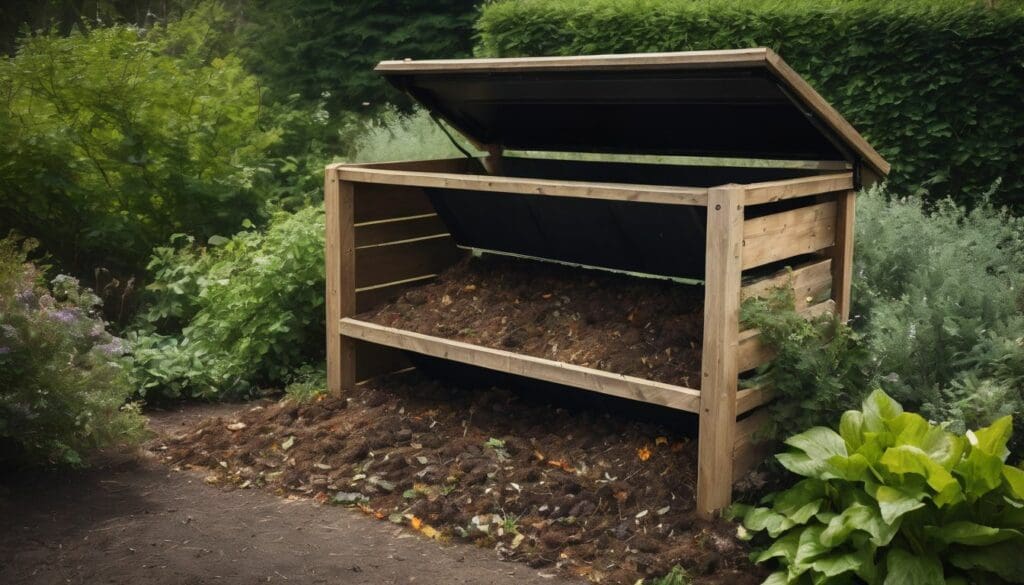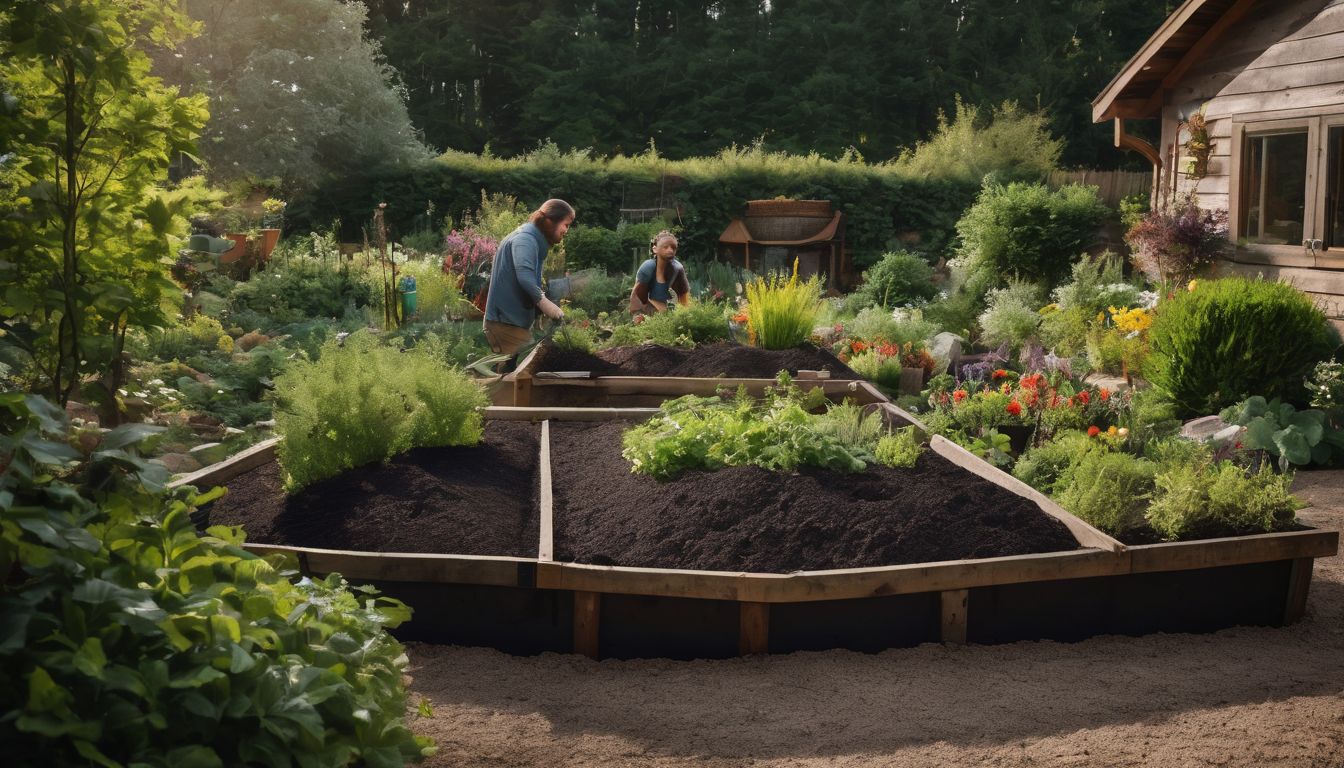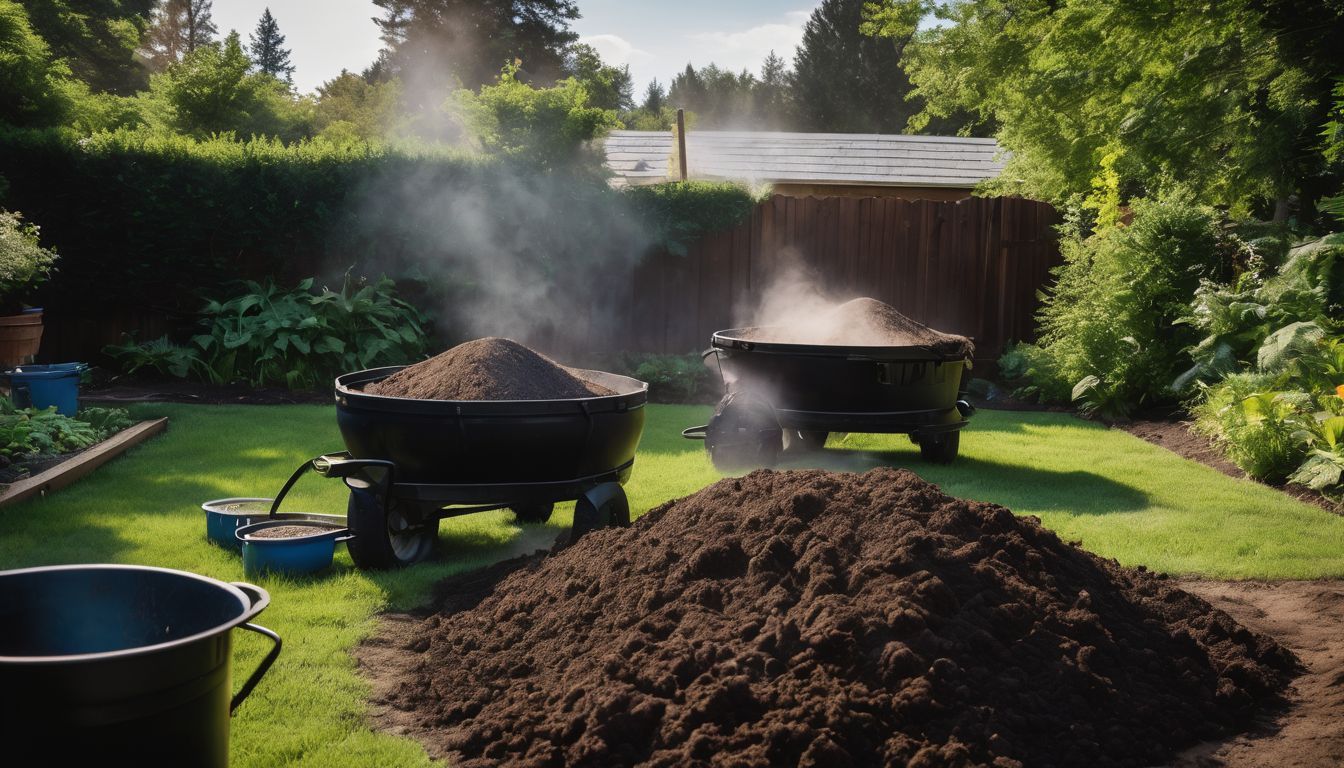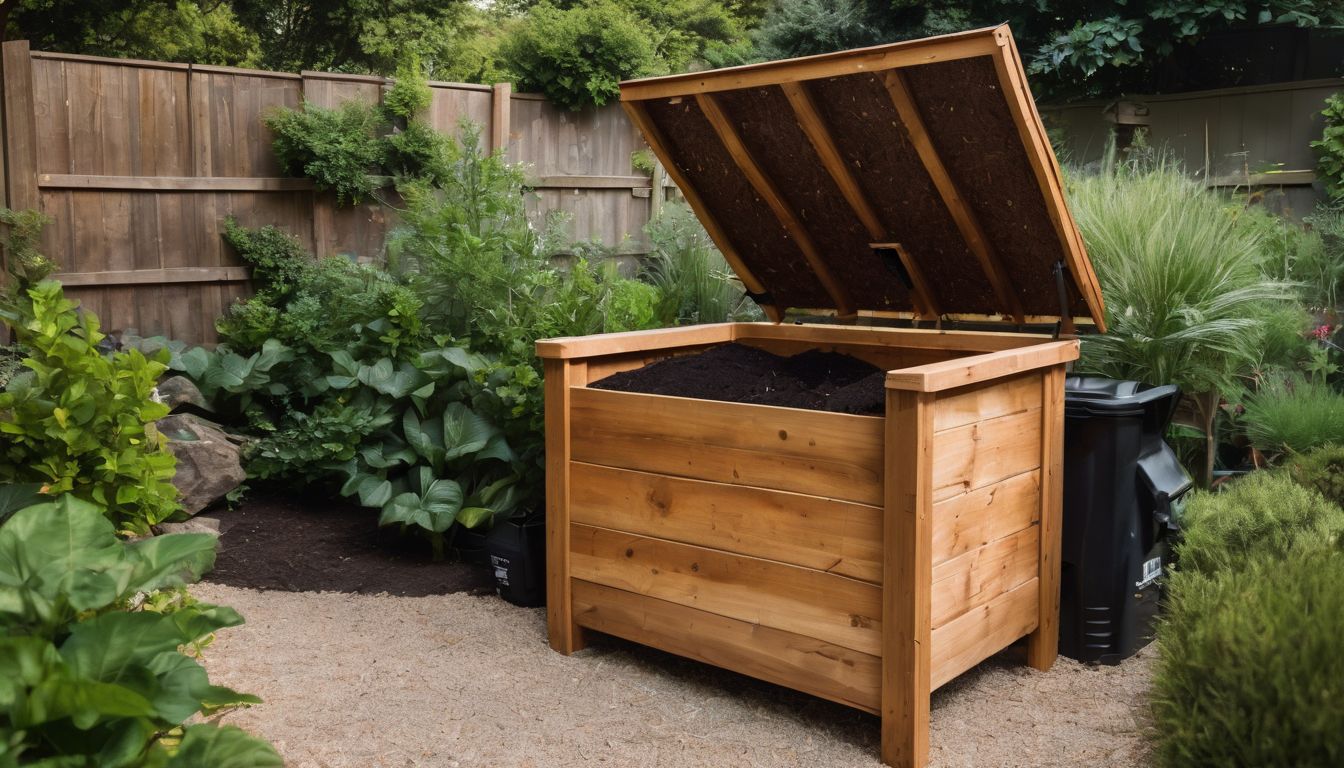Are you tired of tossing out kitchen scraps and garden waste? Composting is an eco-friendly way to turn your organic rubbish into a treasure for your garden. This guide will show you the simple steps to set up a compost bin, transforming waste into nutrient-rich soil.
Let’s get our hands dirty!
Key Takeaways
- Composting is a process that converts kitchen scraps and garden waste into valuable, nutrient-rich soil for your garden.
- By selecting the right balance of green nitrogen-rich materials and brown carbon-rich elements for your compost bin, you can improve decomposition efficiency and soil quality.
- Maintaining your compost bin includes regular turning to aerate the pile, balancing moisture levels, and ensuring it’s free from meat, dairy products, or oily foods that might attract pests or produce bad odours.
- Troubleshooting common issues involves addressing smells by adjusting moisture with dry materials, deterring animals with secure bins and proper placement, and promoting breakdown by adding more brown components if necessary.
- When your compost turns dark and crumbly with an earthy smell after several months to a couple of years depending on various factors, it’s ready to enrich your garden beds.
What is Composting and Why Should You Do It?
Composting is the natural process of breaking down organic materials, like kitchen scraps and yard waste, into nutrient-rich soil. By composting, you can improve soil health, reduce waste going to landfills and prevent plant disease in your garden.
Benefits for soil health
Creating a compost bin in your garden is key to boosting soil health. Rich in nutrients, the compost you produce feeds the earth and aids plant growth. Healthy soil retains water more efficiently, which means less watering and better resilience against droughts.
It also fosters an active ecosystem of beneficial organisms such as worms and bacteria that break down organic matter, naturally aerating the ground.
By adding compost to your garden, you enhance its structure, creating a better environment for roots to spread out comfortably. This leads to stronger plants capable of resisting diseases and pests more effectively.
Such nutrient-rich soil acts as a natural fertiliser, minimising the need for chemical alternatives. Through backyard composting, you are not just recycling waste; you’re enriching the future of your own little patch of earth with every addition to your compost pile.
Reducing waste
Reducing waste is a crucial benefit of composting. By diverting organic materials from landfills, you can significantly decrease the amount of waste that ends up in disposal sites.
This reduces methane emissions and helps combat climate change. Composting also minimises the need for chemical fertilisers, further contributing to environmental sustainability.
Composting at home aids in enriching soil health and reducing overall organic waste. When kitchen scraps and yard trimmings are put into a compost bin, they break down naturally, creating a nutrient-rich soil amendment for your garden.
Preventing plant disease
Preventing plant disease begins with maintaining a healthy compost system. Ensure a proper balance of green and brown matter in your compost to prevent the spread of diseases like mold, fungi, or bacteria that can harm plants.
Regularly turning your compost pile will also help create an environment that reduces the risk of plant disease.
When using your compost in the garden, be selective about which plants receive it. Avoid using immature or diseased compost as this could introduce harmful pathogens to your garden soil and potentially harm the health of your plants.
Choosing a Location and Method for Your Compost Bin
When setting up a compost bin, it’s important to consider whether you want an outdoor or indoor method and the type of compost bin that will best suit your needs. Outdoor methods may include open piles, enclosed bins, or tumblers, while indoor methods can involve worm composting or using a bokashi system.
Outdoor vs. indoor methods
Outdoor composting involves setting up a compost bin or pile in an open space such as a backyard or garden. It allows for larger quantities of organic waste to be composted and is suitable for those with ample outdoor space.
This method provides easy access to sunlight, which helps enhance the decomposition process, and also allows for better aeration and drainage.
On the other hand, indoor composting methods are ideal for those with limited outdoor space or living in urban environments. Options such as worm compost bins or Bokashi systems can be used indoors to efficiently decompose kitchen scraps and other organic materials.
Types of compost bins
There are various types of compost bins available, each suited to different needs and spaces. Here are some options to consider when setting up your compost system.
- Tumbler composters: These are easy to turn and provide aeration for faster decomposition.
- Worm composting bin: Ideal for indoor use, these bins utilise worms to break down organic materials.
- Wooden pallet bins: A cost-effective DIY option that can be easily customised to fit your space.
- Plastic bins: These come in various sizes and shapes, perfect for small gardens or limited outdoor areas.
What to Put In Your Compost Bin
When setting up your compost bin, it’s important to know what materials can and cannot be put in. Green materials like fruit and vegetable scraps, grass clippings, and coffee grounds are great for composting, while brown materials like leaves, straw, and cardboard provide carbon-rich elements.
Green and brown materials
Green materials, such as grass clippings and vegetable scraps, provide nitrogen to the compost pile. They are essential for supporting microbial activity and speeding up the decomposition process.
Brown materials like leaves, straw, and shredded paper add carbon to the mix. They help create airflow in the compost pile, maintain moisture levels, and balance out the high-nitrogen green materials.
Balancing green and brown materials in your compost bin is crucial for a successful breakdown of organic matter. Green materials supply essential nutrients for microbes while brown materials create structure and airflow within the pile.
What to avoid
When starting your compost pile, avoid including meat and dairy products, as they can attract unwanted pests.
- Do not put in any diseased or insect – infested plants to prevent the spread of illnesses to your compost.
- Avoid adding pet waste or cat litter to your compost bin, as it can contain harmful pathogens.
- Refrain from putting in large branches or woody materials that take longer to break down.
- Avoid adding synthetic chemicals such as pesticides or herbicides, as these can harm the beneficial organisms in your compost.
Tips for Maintaining Your Compost Bin
When maintaining your compost bin, remember to regularly layer green and brown materials for optimal decomposition. Check the temperature and moisture levels in your compost pile to ensure it is breaking down properly.
Layering materials
When layering materials in your compost bin, start with a base of coarse materials like twigs or straw to provide airflow. Then, alternate layers of green and brown materials to maintain a balanced mix.
Green materials include fruit and vegetable scraps, grass clippings, and coffee grounds while brown materials consist of dry leaves, shredded paper, and cardboard. Each layer should be moistened to aid decomposition but avoid making the mixture too wet.
Adding a thin layer of soil between each 6-8 inch (15-20 cm) layer provides essential microorganisms for breaking down the organic matter.
Knowing when the compost is ready
After layering materials and maintaining your compost bin, the next crucial step is knowing when the compost is ready. When your compost turns into a dark, crumbly material, it’s an indication that it’s ready to use in your garden.
This process can take anywhere from 2 months to 2 years depending on environmental factors and the materials used. Regularly check the bottom of your compost pile or bin for finished compost, which should be rich in nutrients and have an earthy smell.
Use a screen to separate any larger pieces that are not yet fully decomposed.
Troubleshooting Common Composting Problems
If you start to notice a foul smell coming from your compost bin, it may be too wet and not getting enough air. If animals are being attracted to your compost pile, make sure you’re not adding any meat or dairy products.
And if your materials aren’t breaking down properly, try mixing in more brown materials like leaves or newspaper.
Smelly compost
If you notice a foul odor coming from your compost, it’s likely too wet. To fix this, mix in more dry materials like straw or shredded paper to balance the moisture levels and reduce the smell.
Turning the compost regularly will also help aerate it and prevent anaerobic conditions that contribute to odors. Additionally, avoid putting in meat, dairy, or oily foods as these can make your compost smelly and attract pests.
Another reason for smelly compost could be an imbalance of green and brown materials. Ensure you have a good mix of nitrogen-rich green materials like kitchen scraps and carbon-rich brown materials like leaves or cardboard.
Attracting animals
To prevent animals from being attracted to your compost bin, avoid putting in meat, dairy, or oily foods as these can draw unwanted attention. Ensure the lid of your compost bin is secure and consider placing wire mesh underneath to discourage digging.
Opt for a closed or tumbler-style bin rather than an open pile to deter animals from rummaging through the compost materials.
Choose a location for your compost bin away from areas frequently accessed by wildlife to minimise the chances of attracting them. Regularly turn and aerate the contents of your compost bin to speed up the decomposition process and reduce odours that may attract animals.
Not breaking down properly
If your compost pile is not breaking down properly, it may be due to a lack of moisture. Check the moisture level by squeezing a handful of the materials – it should feel like a damp sponge.
If it’s too dry, add water and mix the contents thoroughly. Another reason could be insufficient airflow within the compost bin. Turn or aerate your compost with a pitchfork or shovel every few weeks to ensure oxygen reaches all parts of the pile, aiding in decomposition.
Certain materials might also cause your compost to break down slowly. Avoid adding large pieces of wood, meat, dairy products, and excessively oily foods as they can hinder decomposition.
Ensure to maintain a proper balance between green and brown materials for an effective breakdown process.
Conclusion
Setting up a compost bin in your garden is an easy way to boost soil health. Choose a suitable location and method for your compost bin, whether it’s outdoor or indoor. By adding the right materials and following maintenance tips, you can create nutrient-rich compost for your garden while reducing waste.
Troubleshoot common problems like smelly compost or attracting animals to ensure a successful home composting system.
FAQs
1. What do I need to start a backyard compost system?
To start a backyard compost system, you’ll need a DIY compost bin or tumbler and organic waste from your kitchen and garden for soil improvement.
2. Can I build my own compost bin at home?
Yes, you can build your own compost bin using various DIY composting techniques and plans, which can make use of recycled materials for sustainable living.
3. How does outdoor composting help my garden?
Outdoor composting creates nutrient-rich soil that improves plant growth while also reducing waste by recycling organic materials right in your backyard.
4. What should I put in my garden’s compost bin to get started?
For an effective beginning in home
composting, mix green items like fruit peelings with brown items such as dried leaves in the composter; this mixture helps the decomposition process create good-quality compost.





